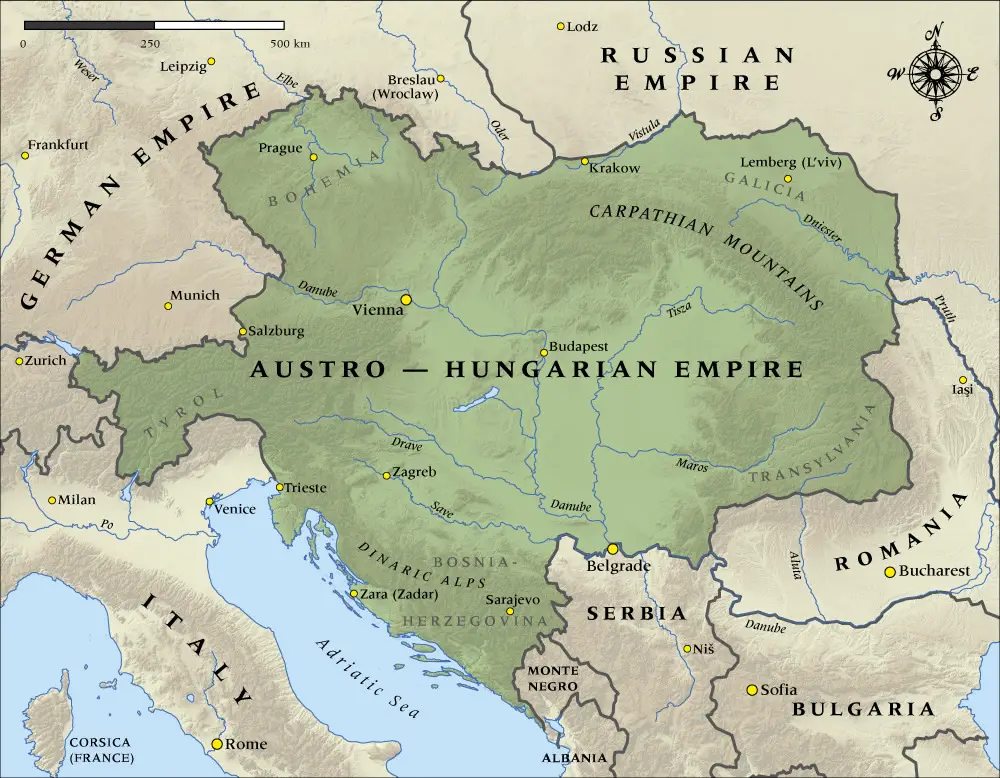The Austro-Hungarian Empire
The Austro-Hungarian Empire was in existence for just more than 50 years. Internal struggles and expansionist ambitions led in part to the start of World War I, which ended in the Empire's defeat and ultimate dissolution. Austria itself had a long history of dominance in European affairs. Austria's capital, Vienna, was one of the most famous cities on the Continent, for its wealth and culture. The Hapsburg dynasty had given way to the Austrian Empire, in 1804. Military defeats at the hands of Napoleon's Grand Armeé began a decline from which the Austrian Empire never really recovered (despite subsequent successes against France), and the Austrian Empire devolved into a partnership with neighboring Hungary that in 1867 became the Austro-Hungarian Empire. During the 19th Century, Austria found itself losing influence and territory, to Italy and Prussia (later Germany); in fact, Austria and Prussia in 1866 fought a war, which Prussia won in just seven weeks. The unifications of both Italy and Germany created both powerful Austrian neighbors and a sense within the Austro-Hungarian Empire of the need for a strong central government. The Empire was a Dual Monarchy, with separate parliaments in Austria and Hungary as well. A common government, with an absolute monarch, was what the paperwork said; in practice, however, the Dual Monarchy was very much in the hands of multiple parties. A Ministerial Council comprised a handful of ministers and archdukes, all of whom advised the emperor. The Austrian government provided money and resources for the Austrian armed forces, and the Hungarian government provided money and resources for the Hungarian armed forces. The emperor, Franz Josef, was in charge of all of this but needed the support of both parliaments in order to enforce orders uniformly.  As did Germany, Austria-Hungary spent large sums of money on industrializing the country, particularly in the area of rail transport, allowing faster transport of materials, goods, and armed forces. Austria-Hungary's spending during the latter part of the 19th Century was marked but not as high as that of Germany, France, or Great Britain. Of particular note, Austria-Hungary's military spending lagged far behind the other European powers. As well, the Austro-Hungarian Empire consisted of many disparate nationalities, of varying Slavic descents. Tensions among neighboring provinces ran high, particularly after the Empire annexed neighboring Bosnia-Herzegovina in 1908. Neighboring Serbia gained a significant amount of territory as a result of a pair of Balkan Wars, in 1912 and 1913. Austria-Hungary felt threatened by not only the newly strengthened Serbia but also nearby Russia, a huge country with a massive military, still smarting from defeat in the Crimean War 60 years before. The Dual Monarchy sought out and ratified an alliance with the other Central European powerhouse, recently unified Germany. Fearing the loss of territory to Serbia, Austria-Hungary was on the lookout for an opportunity to confront its neighbor. Still, the Dual Monarchy might well have been surprised at the bold moves taken by members of the Serbia-supported Black Hand, members of which assassinated the Austro-Hungarian heir to the throne, Archduke Franz Ferdinand, on June 28, 1914, in Sarajevo. In response, but not in a hurry, the Dual Monarchy issued an ultimatum to Serbia, a list of 10 demands, on July 23, nearly a month after the assassination. Imperial Foreign Minister Leopold Berchtold, who had returned from Germany on July 5 with the promise of unconditional military and economic support, expected Serbia to reject the ultimatum. Instead, Serbia accepted all but one of the demands, the one that would have permitted Austrian authorities to investigate assassination suspects within Serbian borders. On this pretext, five days later, Austria-Hungary declared war on Serbia. The date was July 28, 1914. Not long after, Russia declared its support for Serbia and its wartime opposition to Austria-Hungary. The Dual Monarchy was immediately on the back foot, fighting a two-front war. The offensive against Serbia soon ground to a halt and resulted in much bloodshed on both sides, with Austria-Hungary losing half of its armed forces by the end of the year. The tide turned the following year, however, and Austro-Hungarian forces, backed by armies from Bulgaria and Germany, eventually occupied Serbia. Another success came against Italy, which had initially declared its support for the Central Powers but had switched sides in 1915. Despite being outnumbered, Austria-Hungary held the line against Italy. In Russia, however, losses were incredibly high on both sides, with Austria-Hungary, despite the conquest of Romania and a hard-fought victory over Russia in the Battle of Gorlice-Tarnow, losing about 1 million men. As well, the disparate languages and cultures of the Empire created confusion in the ranks of all branches of the armed forces. As a result, the Dual Monarchy became more and more dependent on support from Germany, in the form of both money and manpower. Russia took itself out of the war in 1917, after the Bolshevik Revolution, but Austrian losses in the eastern campaign were so heavy that the Dual Monarchy failed to recover. As German losses mounted in the west, German support in the east waned. Eventually, both countries admitted defeat. With the end of the war came the end of the Austro-Hungarian Empire.
|
|
Social Studies for Kids
copyright 2002–2025
David White




